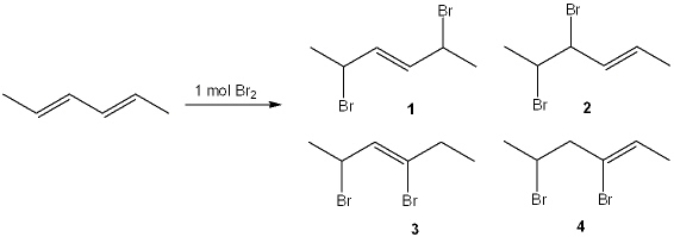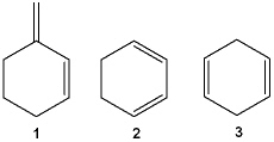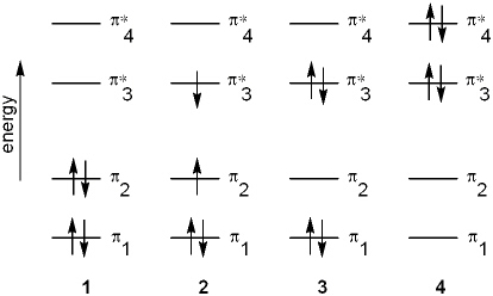A) 1
B) 2
C) 3
D) 4
F) All of the above
Correct Answer

verified
Correct Answer
verified
Multiple Choice
What is the reactive intermediate in the reaction of 1,3-butadiene with HBr resulting in 1,2-addition?
A) cyclic bromonium cation
B) allylic cation
C) allylic radical
D) dienophile
F) All of the above
Correct Answer

verified
Correct Answer
verified
Multiple Choice
What is (are) the major organic product(s) formed in the following reaction? 
A) only 1
B) only 1 and 2
C) only 1 and 3
D) only 2 and 4
F) B) and D)
Correct Answer

verified
B
Correct Answer
verified
Multiple Choice
What is the kinetic product obtained from the addition of 1 mole of bromine to 1,3-butadiene?
A) 3,4-dibromo-1-butene
B) (E) -1,4-dibromo-2-butene
C) (Z) -1,4-dibromo-2-butene
D) (Z) -2,3-dibromo-2-butene
F) B) and D)
Correct Answer

verified
Correct Answer
verified
Multiple Choice
What is the IUPAC name of the following compound? 
A) 2,3-dimethyl-2,4-pentadiene
B) (Z) -2,3-dimethyl-2,4-pentadiene
C) 3,4-dimethyl-1,3-pentadiene
D) (Z) -3,4-dimethyl-1,3-pentadiene
F) A) and C)
Correct Answer

verified
Correct Answer
verified
Multiple Choice
Which of the following arrangements of p atomic orbitals gives the lowest energy p-bonding molecular orbital of 1,3-butadiene? 
A) 1
B) 2
C) 3
D) 4
F) A) and D)
Correct Answer

verified
Correct Answer
verified
Multiple Choice
What is the thermodynamic product obtained from the addition of 1 mole of bromine to 1,3-butadiene?
A) 3,4-dibromo-1-butene
B) (E) -1,4-dibromo-2-butene
C) (Z) -1,4-dibromo-2-butene
D) (Z) -2,3-dibromo-2-butene
F) A) and C)
Correct Answer

verified
Correct Answer
verified
Multiple Choice
What is the systematic IUPAC name of the following compound? 
A) (3S,4E) -3-ethyl-3,4-dimethyl-1,4-hexadiene
B) (3R,4E) -3-ethyl-3,4-dimethyl-1,4-hexadiene
C) (3S,4Z) -3-ethyl-3,4-dimethyl-1,4-hexadiene
D) (3R,4Z) -3-ethyl-3,4-dimethyl-1,4-hexadiene
F) A) and B)
Correct Answer

verified
Correct Answer
verified
Multiple Choice
Which of the following processes takes place upon absorption of ultraviolet-visible radiation?
A) bond vibration
B) electron excitation
C) nuclear spin flip
D) electron spin flip
F) A) and B)
Correct Answer

verified
Correct Answer
verified
Multiple Choice
Which of the following are conjugated dienes? 
A) only 1
B) only 2
C) only 1 and 2
D) 1, 2 and 3
F) None of the above
Correct Answer

verified
Correct Answer
verified
Essay
Provide the structures of the constitutional isomers of the two major organic products obtained from the following reaction?

Correct Answer

verified
Correct Answer
verified
Multiple Choice
Which of the following is(are) formed upon addition of 1 mol of Br2 to 1,3-cyclohexane? 
A) only 2
B) only 1 and 3
C) only 2 and 4
D) 1, 2 and 3
F) A) and B)
Correct Answer

verified
Correct Answer
verified
Multiple Choice
Which of the following arrangements of p atomic orbitals gives the highest energy p-antibonding molecular orbital of 1,3-butadiene? 
A) 1
B) 2
C) 3
D) 4
F) All of the above
Correct Answer

verified
Correct Answer
verified
Essay
Draw two resonance structures of the reactive intermediate that accounts for the formation of 1,2- and 1,4-addition products upon reaction of 1,3-butadiene with one equivalent of bromine.
Correct Answer

verified
Correct Answer
verified
Multiple Choice
Which of the following terms describes the mechanism for the addition of Br2 to butadiene?
A) electrophilic addition
B) nucleophilic addition
C) pericyclic addition
D) conjugate addition
F) None of the above
Correct Answer

verified
A
Correct Answer
verified
Multiple Choice
Which of the following energy diagrams represents the electronic state of butadiene after absorption of radiation? 
A) 1
B) 2
C) 3
D) 4
F) A) and C)
Correct Answer

verified
Correct Answer
verified
Multiple Choice
What is (are) the major organic product(s) formed in the following reaction? 
A) only 1
B) only 2
C) only 3
D) 1, 2 and 3
F) A) and B)
Correct Answer

verified
C
Correct Answer
verified
Multiple Choice
What are the units of absorbance, A, in ultraviolet-visible spectroscopy?
A) J*mol-1
B) nm*mol-1
C) J*mol-1*M-1
D) none, A is a dimensionless quantity
F) All of the above
Correct Answer

verified
Correct Answer
verified
Multiple Choice
Which of the following has the highest value of lmax in the ultraviolet-visible spectrum? 
A) 1
B) 2
C) 3
D) 4
F) B) and C)
Correct Answer

verified
Correct Answer
verified
Multiple Choice
What are the units of lmax in ultraviolet-visible spectroscopy?
A) J*mol-1
B) M-1
C) nm
D) none, lmax is a dimensionless quantity
F) C) and D)
Correct Answer

verified
Correct Answer
verified
Showing 1 - 20 of 44
Related Exams